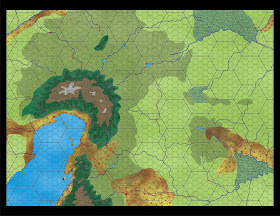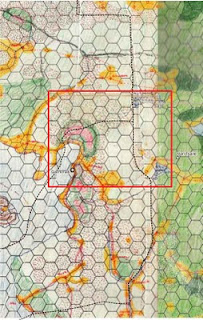My latest Majestic Wilderlands campaign started off very well.
The roster for this game is
Syrivald - a human Mage from the Order of Thoth played by the Rusty Battle Axe
Eoleander of house Nimor - a Elven Fighter played by Dwayne from Gamer's Closet
Ashling Anubus - a Elven Mountebank played by Tim from Gothridge Manor.
The tricky part is getting the characters together. We have a pretty diverse lot here and I like to do this organically as possible.
My scheme was to play on Syrivald's interest in Elessarian Culture. I give him a lead on finding a formula for Pyracantha Oil. This is a the distilled essence of the berries of the Pyracantha plant and somehow makes armor more resistant to blows. Unfortunally the formula was lost during the fall of the Elessarian Empire 2,000 years ago. Even what plant the name Pyracantha refers to is not known.
But what Syrivald has is a letter and a entry from an old Elessarian Codex on herbs that point to the Circle of Hwath as where it was made. However like so much of Elessarian culture it too was lost when the Elessarian Empire fell. However the letter mentions the destruction being caused by the VI Legion of Viridistan. Syrivald believes that VI Legion records can be found in Gormmah.
So Syrivald goes to Gormmah to find those records.
Eoleander is a mercenary in the employ of Nino the Black. Currently Nino is in the pay of the Emperor of Gormmah. Eoleander is tiring of the Mercenary grind and is looking to get out.
Ashling is looking for adventure and excitement and currently gets a lot of it from associating with the criminal element among humans. He recently arrived in Gormmah after hearing of the general lawlessness of the town.
The map of Gormmah is below. I didn't have time to draw up my own version so I adapted the map of Shiran from Harn. One element I wanted was that a recent flood caused a change in the course of the river next to the town. The river is now eroding away the city bit by bit and if nothing is down the whole city will be swept away in a few decades. Shiran was the best fit out of all the cities I had. After the campaign I will replace this with something more original that I can publish.

The game started out with Syrivald crossing the Mandain Bridge into Gormmah proper. After playing 1d (d = silver piece) he was allowed to enter thru the Arna gate. He asked the guard for a good place to stay and the guard directed him to the Green Wyvern which is just up the road from the gate. The guard only asked that Syrivald mentioned to Orsin that Nordin sent him.
(Point A)
So Syrivald went over and checked into the inn. There he rented a private room for 12d/night and took dinner. I probably surprised the heck out of the Rusty Battle Axe when I pulled out not only a floor plan of the Inn but a picture of the Innkeeper. It was just dumb luck that he happened to pick an inn that had a Harn article devoted to it.
(Point B)
Meanwhile Ashling was relaxing in the worst inn in town the Rafter's Inn near the undercut. This section of Gormmah is crumbling into the river and now inhabited by gangs and the urban poor. A member of the Madmen gang named Mardan approached him about doing a job. He was willing to pay Ashing 100d now and 100d at completion. Ashling had to act as lookout and use his sleep spell if any guards was coming. The job involved something worth 10 gold crowns (3200 silver pennies)
(Point C)
Syrivald asked the innkeeper Orsin about where the Archives of the legion was. He was directed to across the road to the Chancery in Caer Shira the castle of Gormmah. He was told to find a clerk named Haradan who interests lies in history and old records. Syrivald went over and introduced himself to Haradan. After Syrivald agreed to pay a gratuity of 10d and a dinner, Haradin would met with him at the Green Wyvern and share what records he has.
(Point D)
Eoleander just got off of a training session when he was called to me with Captain Nino. Nino had a job for him, The Chancery Clerk Haradan needed a bodyguard to escort him to a dinner. The captain told him to clean up, gear up, and get over to Haradan's house on Chyn Way. Eoleander neglected the get cleaned up part and went over smelling rather ripe. There he was greeted by Haradan's wife and waited for the clerk in the court yard.
In the meanwhile Ashling met with Mardan and his accomplices; a Burgler, another Mountebank and a Thug. The job involved robbing Haradan's house! When they got there Ashling and the other Mountebank were positioned at opposite ends of the street to watch for guards. Maradan, the burglar, and the thug went around to a back alley and made their way to the house.
Haradan greeted Eoleander and the two left the house. They failed to spot Ashling. When they were halfway up the road, they hear a loud crash from behind Haradan's house and the scream of Haradan's wife. The two go running back. After to making sure that the wife and Haradan's daughter were OK, they investigate the crash. In the back they find the exterior stairway to the third floor tenement to have collapsed. In the wreckage was the unconscious body of the Thug. Eoleander sent Haradan out front to check for anybody fleeing and to call the guards. While doing this the Thug was beginning to awake. Eoleander cold cocked him with the butt of his Knight Killer Crossbow. This severely injures the thug taking him into negative hit points..
Ashling pushes further back in the shadow as the guard being called and chaos erupting around him. He spots Mardan and the burglar fleeing down a side street. He nails them both with a sleep spell and runs toward them. Before anybody can react or understand what was happening Ashling grabs the sacks and runs away from the area. When he finally stops to catch his breath he opens it up. All he finds are two silver candlestick, a ornate box with a small codex in it. Briefly reading it Ashling notes that about various ruined Trehaen Circles in the region. One of them he noted was the Circle of Hwath.
Note that from the crash on I was pretty making everything up on the fly. My original thought was that Ashling would follow Eoleander and Haradin back to the Green Wyvern. To my horror there was a big plot hole in that I gave no compelling reason for why Ashling would follow them. Luckily I realized this moments before so I improvised the crash and the resulting chaos.
(Point C)
After the City Guard hauled the Burglar, the Thug, and Mardan away, Haradan and Eoleander went to the Green Wyvern. Note the guard attributed the Thug's injuries to the fall. Once at the inn, Haradan and Syrivald enjoy a pleasant dinner. Haradan was able to help Syrivald in finding the location of the Battle of the Three Hill and giving him some tips on where to find Hwath.
During the conversation Ashling decides not to return to the Rafter's Inn and heads to the Green Wyvern. I really lucked out with this decision. It helped that there are only two inns in Gormmah. There he enters the inn and rents a room. Syrivald and Haradan are sitting at a table right next to the bar and when they mentioned Hwath, Ashling decides to order a drink and eavesdrop. Eoleander fails to notice that Ashling was seen fleeing the incident at Haradan's house.
The conversation winds down between Haradan and Syrivald. Syrivald starts talking about what he needs to do to travel to Hwath. The journey going to be made difficult by the fact that the northern half of Gormmah is under the control of Tarngol to the west. (Note this campaign is nearly 20 years after the events in Supplement VI) . Haradin recommends Eoleander despite his smell and introduces Syrivald to him.
The two being talking and come to a quick agreement that it would be profitable to adventure together to Hwath. During the conversation Ashling approaches them and offer them his services. Ashling rattled off the few facts he read in the codex and Syrivald was impressed. The two of them agreed to include Ashling.
After this the dinner broke up. Eoleander escorted Haradan back to his house while Syrivald and Ashling continue to talk. Ashling's original plan was to read the codex and pretend that he was an expert. This fell by the wayside when he realized that his knowledge of the terrain to the north was much more valuable to the party. He revealed the codex and the two agreed that it must be of considerable value for the Madmen to steal it. They agree on a plan to copy the codex. One copy would be a forgery and delivered to the Madmen. The forgery would be altered so that only the party would know where Hwath was. The second copy would be accurate and be retained by the party. The original would be returned to Haradan for a reward. The copying would take two days to do plus materials.
Everybody retired for the night and met the next morning at the Green Wyvern.
 Mind you this appear and emphasize appears to be a distilled version of 4e. This is the product page is here.
Mind you this appear and emphasize appears to be a distilled version of 4e. This is the product page is here.






